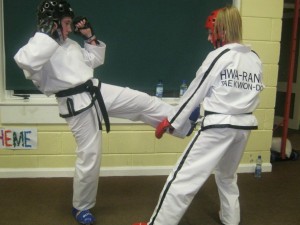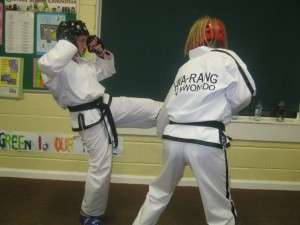Counter Attacking Sparring Option
Ever find yourself frustrated with your sparring when you execute a kick only to find your opponent is just that tiny bit out of range? Well, take heart as it can be a common feeling so this article looks at the advantages of counter-attacking as opposed to initiating the attack.
Understanding range or distance between you and your opponent and getting the all-important timing bang on can be way harder when you mount an attack first. Distance, timing and accuracy skills should be practised and drilled in all sparring training. No doubt that you will succeed in scoring sometimes when you mount an attack first, but you must close down the distance between yourself and your opponent, and allow for your opponents various adaptations to your attack. Scoring when you attack first will work, but these three fundamental skills and competent athleticism are paramount to success.
Disguising your intentions until the last possible minute and faking a dummy chamber for one kick while doing another should also work, if honed enough. However I strongly advise to lookinto how adapting the role of counter-attacker could lead to greater sparring success.
THE MINDSET OF THE COUNTER FIGHTER.
It will not happen overnight, it has to be a deliberate mindset to have the patience to lure your opponent to attack first. A counter-attack mindset may also aid instructors in retaining students as it is certainly a safer, easier and faster way to get to grips with the art of sparring. After all, it is very hard to be aware of any negative impact that a student feels after sparring. While most people will not admit to their unpleasant sparring encounters, it is worse to hear they have dropped out of training altogether. This could be due to a lack of fundamental understanding of the easy and safer option of counter attacking.
Taekwon-Do kicks will come either in a straight line towards you, such as the front kick, the side kick, back side-kick, or axe kick. Or in a circular motion, like the spinning back or the turning (roundhouse) kick. This time we will look at how best to avoid the front kick and counter-attack it simultaneously.
While moving back away from a kick or punch is a valid natural reaction, the counter-attacker will rarely move directly back. My definition of moving back here is moving back in such a way you end up out of range to mount a successful counter. While the goal obviously is not to get hit, moving away out of range only has the advantage of not getting hit. Moving in towards the attack, but in a circular move has the advantage of counter-attack as well.
THE SEQUENCE
In the first picture both fighters face off.
 In picture number 2 Maria (Black head-guard) fires a middle front kick. Nicole (Red head-guard) moves straight back, and has limited her options. Why? Because yes she can kick, back but because she has moved back too far, her opponent Maria has time to see any counter coming.
In picture number 2 Maria (Black head-guard) fires a middle front kick. Nicole (Red head-guard) moves straight back, and has limited her options. Why? Because yes she can kick, back but because she has moved back too far, her opponent Maria has time to see any counter coming.
 Now in the third picture she does better. Nicole has blocked the kick but has turned or pivoted in towards her opponent where she can punch quickly, and has the advantage of surprise and only a tiny distance to cover to score with a punch. Her opponent Maria has a distinct disadvantage of not having enough reaction time available.
Now in the third picture she does better. Nicole has blocked the kick but has turned or pivoted in towards her opponent where she can punch quickly, and has the advantage of surprise and only a tiny distance to cover to score with a punch. Her opponent Maria has a distinct disadvantage of not having enough reaction time available.
In other words she is moving in towards, rather than away from the front kick. This skill must be drilled quite a lot in order to get the pivot, block, with the timing bang on in such a way they all happen simultaneously. It will take mutual co-operation to build the level of aggression and strength of attack into the training.
 In the last picture Nicole is now inside Maria’s range of attack so from here she can easily counter with a punch combination. If she simply moved back she would always end up too far away to counter-attack successfully. She could of course counter with a spinning kick, and we will cover this next month, however the objective of counter attacking especially at an early stage is to try and move in toward as opposed to moving out and away. This drill could also suit students of limited flexibility and wish to improve their footwork.
In the last picture Nicole is now inside Maria’s range of attack so from here she can easily counter with a punch combination. If she simply moved back she would always end up too far away to counter-attack successfully. She could of course counter with a spinning kick, and we will cover this next month, however the objective of counter attacking especially at an early stage is to try and move in toward as opposed to moving out and away. This drill could also suit students of limited flexibility and wish to improve their footwork.
HOW TO PRACTISE
Try the drill this way.
- Both partners face each other. They are both moving ever so slightly while remaining in this position, with small elements of bouncing or weaving.
- When the instructor shouts “Kick” the drill begins. Then one kicks while the partner blocks and counters.
- The goal is to move out of the way of the kick, but within striking distance, and counter as fast as possible. The ultimate goal is to get it so good your block/parry and counter happen together.
- Keep trying to knock seconds off your reaction time with each repetition. Wherever they end up they face each other again, both in fighting stance, but slightly on their toes and weaving about, then upon the command of “Kick” and the drill repeats.
- I suggest perhaps at least six each side then change.
If you are intimidated about sparring, (and who isn’t…?) try and break elements that will suit your style into manageable chunks. When you initially try, it may not flow so easily. You may have one partner too heavy in attack or on the other extreme not being realistic enough and firing the kick way off target making the kick too easy to block. We all witness this in three step and two step sparring, where the attacker fires the punch way off out to the side doing a disservice to their training partner.
I would like to thank Maria O’Flaherty and Nicole Canty of the Hwa Rang Do Taekwon-do School in Cork for their assistance with this article, which was written for Totally Taekwondo Magazine and which I highly recommend as reading for any Taekwondo enthusiast.
Until then keep your guard up, and train safely.
Respect
Frank Murphy





